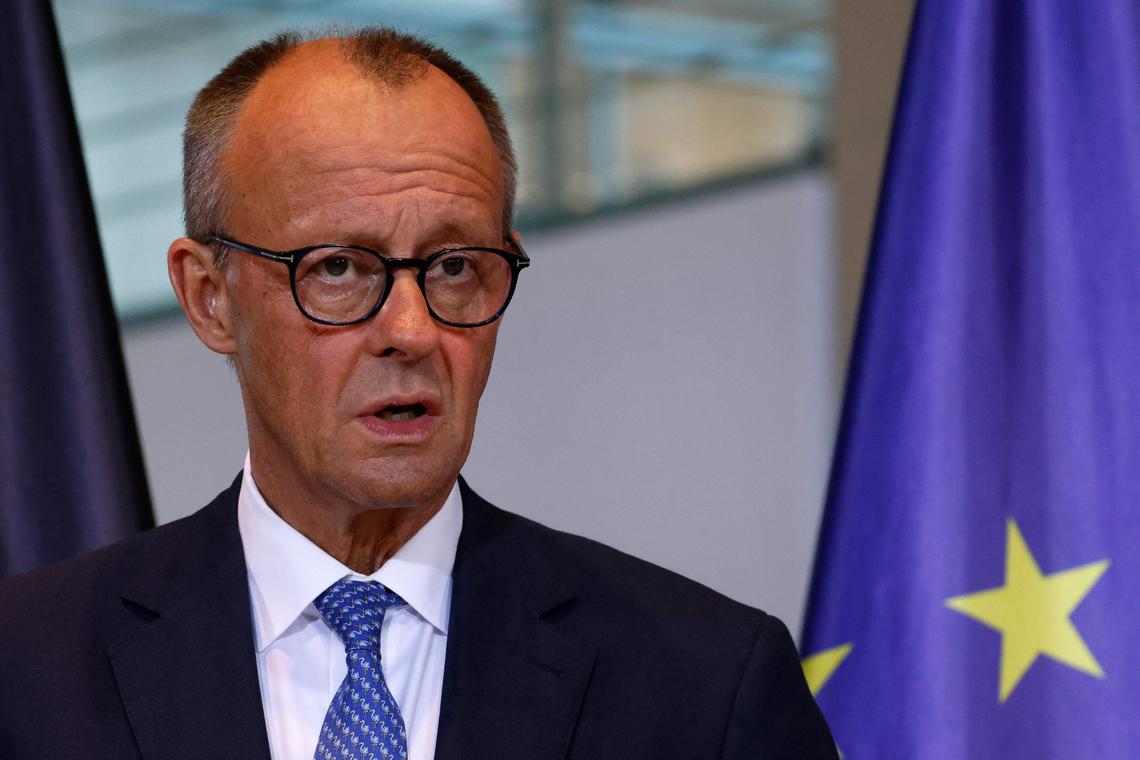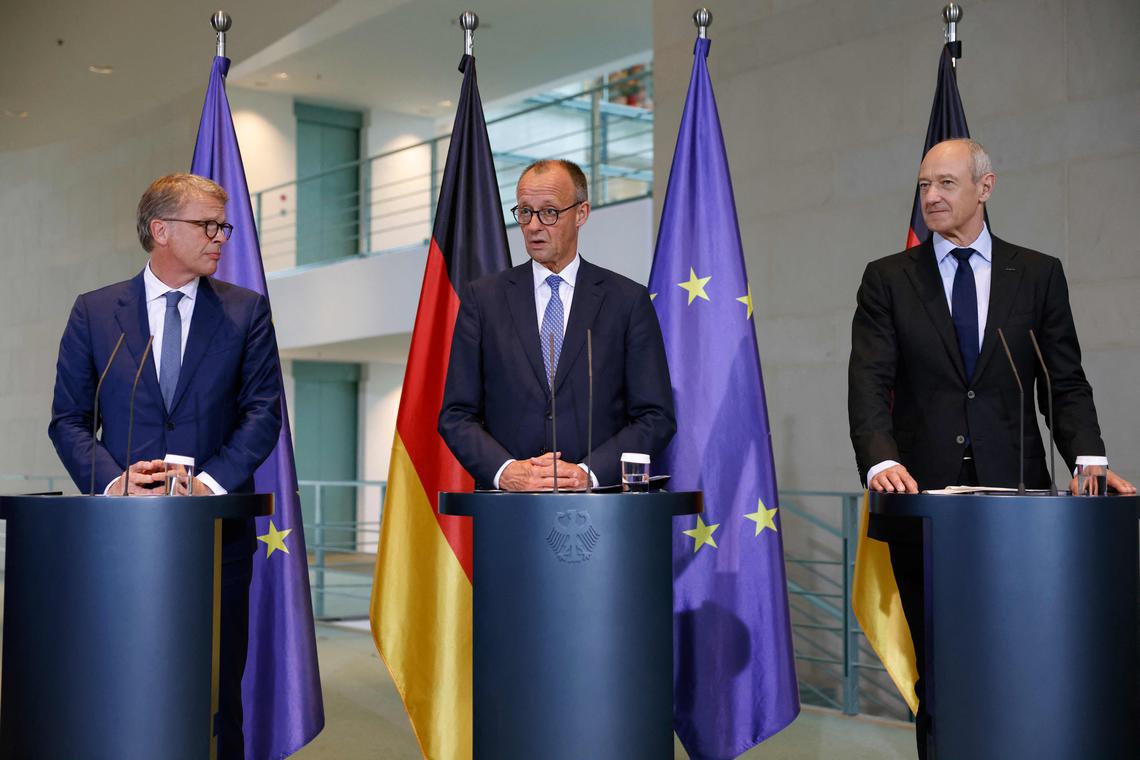BERLIN – When Chancellor Friedrich Merz stepped in front of the cameras on July 21 and declared “Germany is back”, the image was designed to inspire confidence.
Surrounded by executives from Siemens, Deutsche Bank, BMW and other German corporate heavyweights, Mr Merz presented what he labelled as one of the country’s largest investment initiatives in decades: €631 billion (S$936 billion) pledged through 2028, under the “Made for Germany” banner.
It was a grand show of unity between government and business at a time when the German economy, Europe’s largest, has marginally contracted in each of the last three years.
But the symbolism belies a more sober reality. Much of the pledged investment had already been planned. Only a fraction – a still substantial €100 billion – qualifies as new capital. And even that figure is shrouded in vagueness.
While impressive on paper, Mr Merz’s initiative risks becoming a rhetorical exercise detached from the structural reforms that Germany desperately needs. In that sense, “Made for Germany” represents less of an economic breakthrough than a narrative reset.
Its closest analogues – French President Emmanuel Macron’s “Choose France” summit and Chinese President Xi Jinping’s “Made in China 2025” strategy – have clear agendas. Mr Macron courted foreign capital with tax incentives and regulatory reform, while Mr Xi laid out a centralised road map to dominate future tech sectors.
Germany’s effort, by contrast, is still a rather vague call for private investment by its corporate giants and seems more inward-facing.
The pivot from “Made in Germany” to “Made for Germany”, though, signals a shift in ambition. Mr Merz wants to move away from branding Germany as a source of globally trusted exports to renewing the industrial foundations at home to bolster its future competitiveness.
Mr Merz’s goal is not just growth, but a reanimation of Germany’s industrial spirit – an effort to restore geopolitical relevance and economic sovereignty at a time of a seismic rejigging of the global economic order.
To be sure, Germany remains a leading global manufacturing power – contributing about 26 per cent of the EU’s total industrial output and far ahead of France, Italy or Britain – but the system is showing signs of fatigue.
Pressure is also building from outside the European Union.
Though European Commission negotiators have brokered a deal with US President Donald Trump to almost halve tariffs on European goods to about 15 per cent, Mr Merz has warned that these tariffs “pose a serious burden for Germany’s export-oriented economy”.
And then there is China, paradoxically a rival and an indispensable trade partner, and whose own industrial policy has compounded its overcapacity issues.

German Chancellor Friedrich Merz addresses journalists at the launch of the ‘Made for Germany’ initiative planning large investments to boost the economy, at the Chancellery in Berlin, on July 21.
PHOTO: AFP
Many have accused Beijing of exporting its overcapacity to other parts of the world, including South-east Asia and Europe.
German automakers and chemical giants rely on Chinese demand, but
China’s push into electric vehicles,
green tech and microchips has turned it into a fierce competitor. Recent talks between China and the EU have yielded little to resolve deep disagreements.
Mr Merz’s campaign is therefore an attempt to rewrite Germany’s economic story, or at least the way it is told. Many economists would argue that perception drives confidence, and confidence drives investments.
The Merz government argues that private investment is the key to unlocking further growth. The economic theory is Keynesian – inject capital now, reignite demand, and rebuild momentum.
But caution prevails. While short-term effects may lift the gross domestic product in 2026, the long-term trajectory remains weighed down by unresolved structural burdens.
The problem is therefore not a lack of investment promises, but the ecosystem through which those investments must flow.
According to a recent report by the German Bundesbank, the country’s central bank, Germany’s economy could have grown 50 per cent more between 2021 and 2024 if its export industries had not been constrained by labour shortages and regulatory delays.
The German economy is over-regulated, grappling with high energy costs and sluggish digitalisation. The infrastructure is visibly deteriorating, and despite recent public investment packages – including a €500 billion state fund for climate and transport – progress is slow.
At the same time, wage costs are rising, and social contributions are set to increase again in 2026 – all against the backdrop of an ageing population and labour market tensions.
All of these structural impediments are in turn manifesting in the form of funding delays, fragmented policymaking and lagging venture capital inflows, which continue to hinder progress and crimp innovation.
Many of these issues in Germany mirror the ones identified in a 2024 report on European competitiveness anchored by Mr Mario Draghi, a former European Central Bank chief.
Still, the high-tech strategy within Mr Merz’s “Made for Germany” campaign outlines bold plans: chip plants, AI gigafactories and quantum research labs. Germany even aims to derive 10 per cent of GDP from artificial intelligence (AI) by 2030.
Strengthening German innovation was one of the priorities that Mr Merz identified for this campaign, but details were scarce at his launch speech.
Many experts remain sceptical. A recent Organisation for Economic Cooperation and Development report notes that Germany’s AI investment remains modest compared with the US and China, and the commercialisation of research is still weak.
Most tellingly, one in four German tech start-ups is considering relocating abroad due to a lack of venture capital, according to a recent Bitkom survey. Bitkom is Germany’s digital association, representing more than 2,200 companies in the digital economy.
This tension between ambition and inertia is mirrored in the composition of the “Made for Germany” initiative. While Mr Merz presents the campaign as a national effort, it is driven largely by major blue chips listed in Frankfurt, such as Siemens and Deutsche Bank.
Absent are the small and medium-sized enterprises (SMEs) that make up over 90 per cent of German companies and form the backbone of the country’s manufacturing economic base.
The omission is not trivial. The most pressing structural reforms – cutting red tape, accelerating permit approvals, reducing non-wage labour costs and upgrading digital infrastructure – would disproportionately benefit SMEs.
Unlike large firms, they often lack in-house capacity to navigate Germany’s rigid regulatory ecosystem. A family-run engineering business seeking to expand might wait over a year for zoning or environmental permits, all while grappling with rising payroll costs and outdated broadband infrastructure.
Professor Rainer Kirchdorfer, chairman of the Foundation for Family Businesses and Politics, welcomed the initiative’s intentions but criticised its skewed composition.
“Family-owned businesses provide 60 per cent of all jobs. They are essential to Germany as a business location,” he said. Yet only three family-owned companies were invited to the launch.
What is needed now is not rhetorical inclusion, but policy recalibration.
Integrating SMEs into the industrial renewal effort would require targeted reforms – streamlined permitting, better access to venture and growth capital, and relief from inflexible labour costs.
Without this, Germany risks cementing a two-speed economy: one where flagship firms receive capital and attention, while the broader Mittelstand – the storied ecosystem of family firms and specialised manufacturers – remains underleveraged.
This also points to a deeper structural issue. SMEs are rarely seen as leaders in emerging sectors like AI or quantum computing, which could then lead to a policy and funding bias towards larger firms.
But empowering the Mittelstand would localise supply chains, broaden innovation beyond urban hubs and strengthen regional economies.
There is no meaningful reindustrialisation without the Mittelstand – and until SMEs are fully embedded in the plan, “Made for Germany” remains a half-built foundation.
Critics across the political spectrum have begun asking whether the new initiative is simply a polished public relations exercise orchestrated by a handful of chief executives and communications consultants.
Mr Christian Durr, head of the liberal Free Democratic Party, put it bluntly: “This isn’t just about meeting with hand-picked CEOs. The entire spectrum of the economy needs to be heard.”
Still, there is potential in the initiative if backed by real reform.
Germany retains deep technological expertise and a powerful industrial base.
The defence sector, for example, is now awash with funds and could become a driver of innovation, especially through dual-use applications. More than just capital, this would require vision, coordination and political courage.
“Made for Germany” offers hope, but for now, little hard evidence of systemic change.
-
Markus Ziener is a professor at Media University Berlin and writes on political and security issues.
